Volkswagen Tiguan Service and Repair Manual: Tires, Evaluating
Flat Spots
What is a Flat Spot From Standing?
Terms like flat portion, flattening, are also used as a term for flat spots from standing.Flat spots from standing cause vibration, like an incorrectly balanced wheel. It is important to recognize a flat spot in the tread from standing as such!
Flat spots from standing cannot be corrected by balancing, and can occur again at any time under various circumstances. Flat spots from standing can be corrected without complicated special tools. Providing that the flat spot was not caused by wheel lock during hard braking.Note
- Wear spots due to wheel lock are irreparable! Tires with such damage must be replaced.
- Causes of Flat Spots from Standing:
- The vehicle stands for several weeks in a location without being moved.
- Tire pressure is too low.
- The vehicle was placed in a paint system drying cabinet after painting.
- The vehicle was parked with warm tires in a cold garage or similar for a long time. In this case, a flat spot can develop overnight.
Correct the flat spots.
Cracking
Cracking is the term for shallow cracks in the sidewall of the tire.
They run starting from the bulge in the direction of the tire shoulder. See Illustration for the mentioned components.
The cause is the increase in material at the joints of the tire components.
Cracking has no effect on
- Safety,
- Service life,
- Vehicle handling
- Other characteristics of the tire.
Cracks can be of varying visibility. Removing the tire from the rim or an examination is not necessary.
How did the cracks form?
Modern steel belted tires are constructed with single-ply sidewalls to save weight.
The sidewall components consist of long strips before they are joined together to form a tire. They must overlap at the joints. Small irregularities/ripples form in the area of the overlapping components. The overlaps are easier to see from the outside due to the single-ply construction.
Heel and Toe Wear → Chapter "Heel and Toe Wear"
Wear Spots
- A wear spot is a flat spot on the tread of the tires that can be caused by extreme braking maneuvers on subsurface such as asphalt.
- At the same time a tire during the braking maneuver is rubbed at selective points which causes a tire imbalance.
- The consequences of a wear spot is strong vibrations in the vehicle, which can lead to a worsening of the driving behavior and a higher noise generation.
- In most cases the tire tends to lock up due to the larger running surface at this location even with a slightly reduced braking effect leading to an increase in the vibrations.
- Only for low intensity wear spots can the vibrations disappear after a short time through further wear on the tire.
Caution
"Large" wear spots due to wheel lock are irreparable! Tires with such damage must be replaced.
Tire Sidewall Swelling
A swelling in the flank of the tire indicates that the substructure of the carcass has been damaged.
Typical causes for such damage include, for example, driving over curbs at a sharp angle.
Pinching the carcass of a tire this way can damage the carcass.
The substructure of the tire is stretched so far that individual fibers in the carcass may break.
The extent of the damage depends on the speed of impact, the angle of impact, the air pressure, the axle load and the type of obstacle.
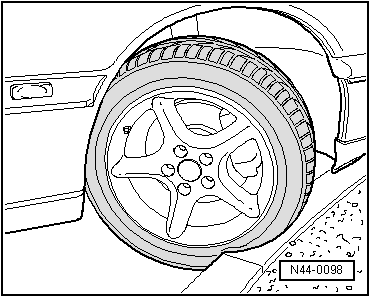
Evidence of Pinching on the Sidewall of a Tire -arrows-
Note
- Driving over curbs must be avoided!
- When it cannot be avoided, curbs should be driven over very slowly at the bluntest possible angle.
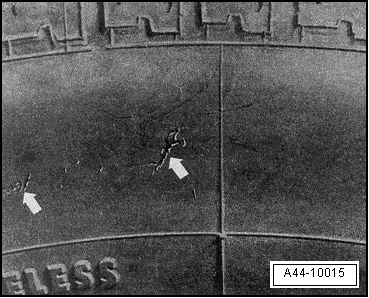
Interior View of a Tire with a Punctured Carcass.
Due to a severe impact, the carcass was pinched on the rim flange and is ruptured in the contact patch.
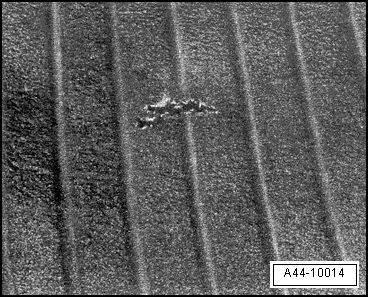
Inside Tire Damage Due to Impact Damage (Double Rupture)
Double rupture -arrows- caused by pinching when driving over a curb. Often not detectable from outside.
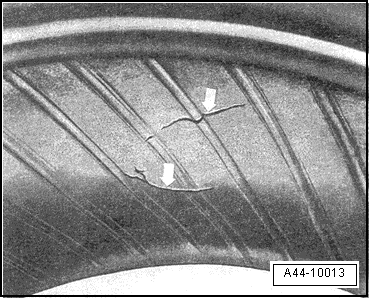
Cuts
Cut Caused by a Sharp-Edged Obstacle -arrow-.
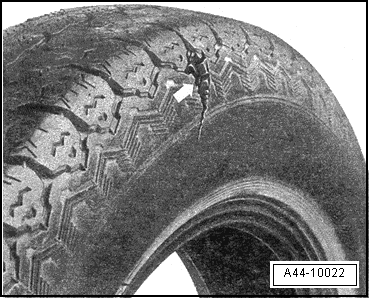
Foreign Object Damage
Driving over hard, pointed objects like nails, screws and the like can pierce the tire.
This always leads to tire damage.
Damage from Imbedded Foreign Bodies
Frequently, the foreign object -marking- is so securely embedded in the tire that it will not free itself even at higher speeds. Due to this, it can act as a plug and seal the tire relatively well. The result is gradual loss of pressure which the driver does not notice immediately but which can lead to sudden and complete tire failure.
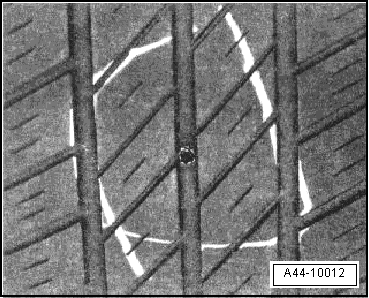
Note
No repair should be attempted on steel belted tires of which the structure has been punctured by a foreign body.
Disintegrated Tread
Tires with Torn-Out Tread
Such damage usually develops over a longer period of time. If an already damaged tire is exposed to high stress, the centrifugal force at higher speeds can tear components off the tire.
Illustration shows a tire with torn-out tread due to driving with insufficient tire pressure.
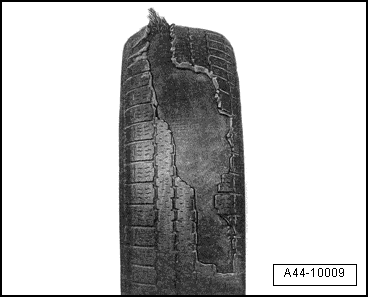
Tires, Damage from Low Tire Pressure
The most common causes of failure are small external damage, a defective valve or a leaky rim due to corrosion or damage.
Separation of Carcass and Rubber
Strong heating due to driving with substantially insufficient pressure led to overheating and subsequent separation of carcass from rubber material -arrows-.
The tire shown here was sporadically driven with tire pressure insufficient for the load. Typical indications for this are the circumferential abrasions in the area of the bead caused by the rim flange and the discoloration. Small, furrowed folds are visible along the inner sidewall.
When the tire rolls, strong shear forces develop between the steel belt layers, especially at the ends of the belts.
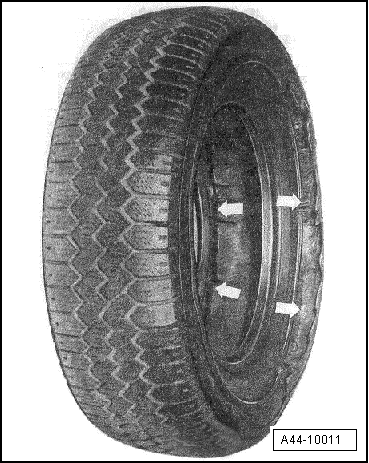
Tires with Wide Furrows Along the Circumference in the Area of the Bead
Wide furrows along the circumference in the area of the bead -arrows- indicate that the tire was driven with insufficient air pressure.
Driving a vehicle with insufficient tire pressure or ignoring or not recognizing tire damage can have serious consequences.
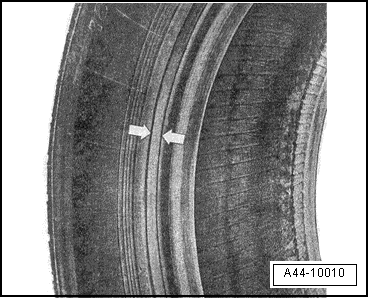
The tire can no longer withstand the forces developing during travel.
The function of the tire is limited by the defects mentioned above. The rubber compounds separate from one another, resulting in partial separation of tire components up to complete destruction.
Inspecting Tires
Because tire damage can have serious consequences, the technician and the driver should regularly check the tires, as it is the best form of early problem recognition.
Pre-damaged tires cannot withstand driving situations like high vehicle speed, long driving distance, sporty driving style and similar situations.
Damage can occur from various causes:
- Driving with low tire pressure
- Mistakes during tire mounting
- Damage during run-in
- Aging
- Incorrect storage
WARNING
As soon as a safety risk cannot be ruled out, the tire must be replaced.
Pay special attention to the following criteria when examining the tire:
- Surface erosion or marbling on the inner side (pressure was too low or insufficient for the load)
- detached rubber or loose cords
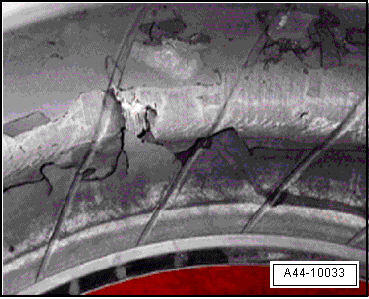
- Exposed or deformed bead bundle
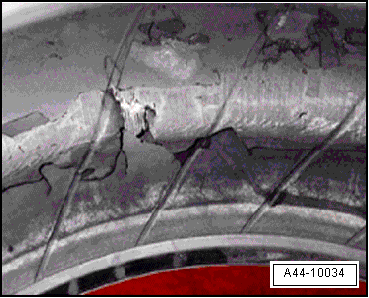
- Damage to tire bead with visible cords
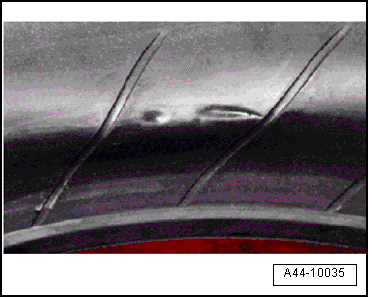
Mounting Damage
Bundle broken during tire inflation.
Modern radial car tires are mounted only on safety rims. These have a hump -1- running along the shoulders.
- Hump (H2)
- Inner bead seat
- Rim
- Wheel disc
- Outer bead seat
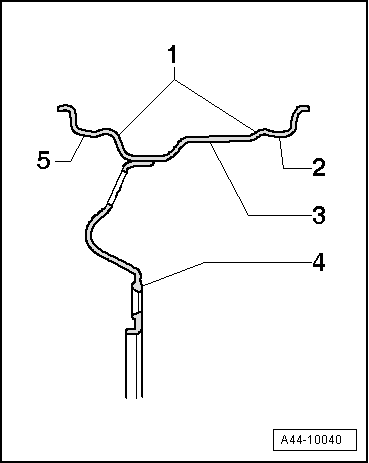
The hump prevents the tire from being pressed out of the bead seat during travel with insufficient tire pressure.
When the tire is inflated, the tire bead may not slip completely over the outer rim hump.
In this case, there is the danger that the bead bundle will be overstretched if the tire pressure is too high and the steel wires rupture partially or completely. Torn bundles are often not detectable from outside.
DANGER!
- Tires with damaged bead bundles are not seated safely and securely on the rim. Such tires are a safety risk!
- In addition, there is the danger that a partially broken bundle tears during continued operation and the tire suddenly tears open. If the bead bundle breaks during inflation, the carcass will also be destroyed.
 Vibration
Vibration
Vibration, Causes for Vibration
There are many causes for vibration. Vibration can also be caused by tire wear,
among other things. Tire wear caused by driving does not always develop evenly
over th ...
 Tire Wear
Tire Wear
Tire Service Life, Influences
The following factors influence the service life of a tire in varying
degrees.
Driving style:
Speed
Brakes
Acceleration
Cornering
Service;
Tire Pressure
Area:
...
See More:
Volkswagen Tiguan Owners Manual > Vehicle tool kit: Folding chocks
Fig. 188 Unfolding the folding chock.
Read and follow the introductory information and
safety information first⇒Introduction
to the subject The folding chock is in the vehicle tool kit ⇒ Fig. 187 .
Setting up the folding chock
Raise the support plate ⇒ Fig. 188① .
Inser ...
Volkswagen Tiguan Owners Manual
Volkswagen Tiguan Service and Repair Manual
- Body exterior
- Body Interior
- General Paint Information
- Paint
- Brake System
- Suspension, Wheels, Steering
- Wheel and Tire Guide
- Towing Guide
- Wheel and Tire Guide General Information
- Communication
- Electrical Equipment General Information
- Electrical Equipment from 06/2011
- Heating, Ventilation and Air Conditioning
- Refrigerant R134a Servicing
- 6-Speed Manual Transmission 02Q, OBB, and OFB
